HRM Portfolio: Changes, Productivity, and Technology in Australia
VerifiedAdded on 2022/09/15
|11
|3258
|22
Report
AI Summary
This assignment delves into critical aspects of Human Resource Management (HRM) in the Australian context. It begins by outlining contemporary changes in work and employment patterns, focusing on shifts in the labor force and skills shortages, and examines the implications for HR managers. The report then assesses the role of HR in enhancing worker productivity, addressing the challenges of Australia's lagging performance compared to OECD countries, and explores strategies for improvement. Furthermore, it analyzes how technology and automation will affect the future of work, particularly within the transport and retail industries, and examines the role of HR in managing these effects. Finally, the assignment critically analyzes whether data analytics can replace people-driven HRM for workplace planning and employee performance measurement, providing relevant examples to support the analysis.
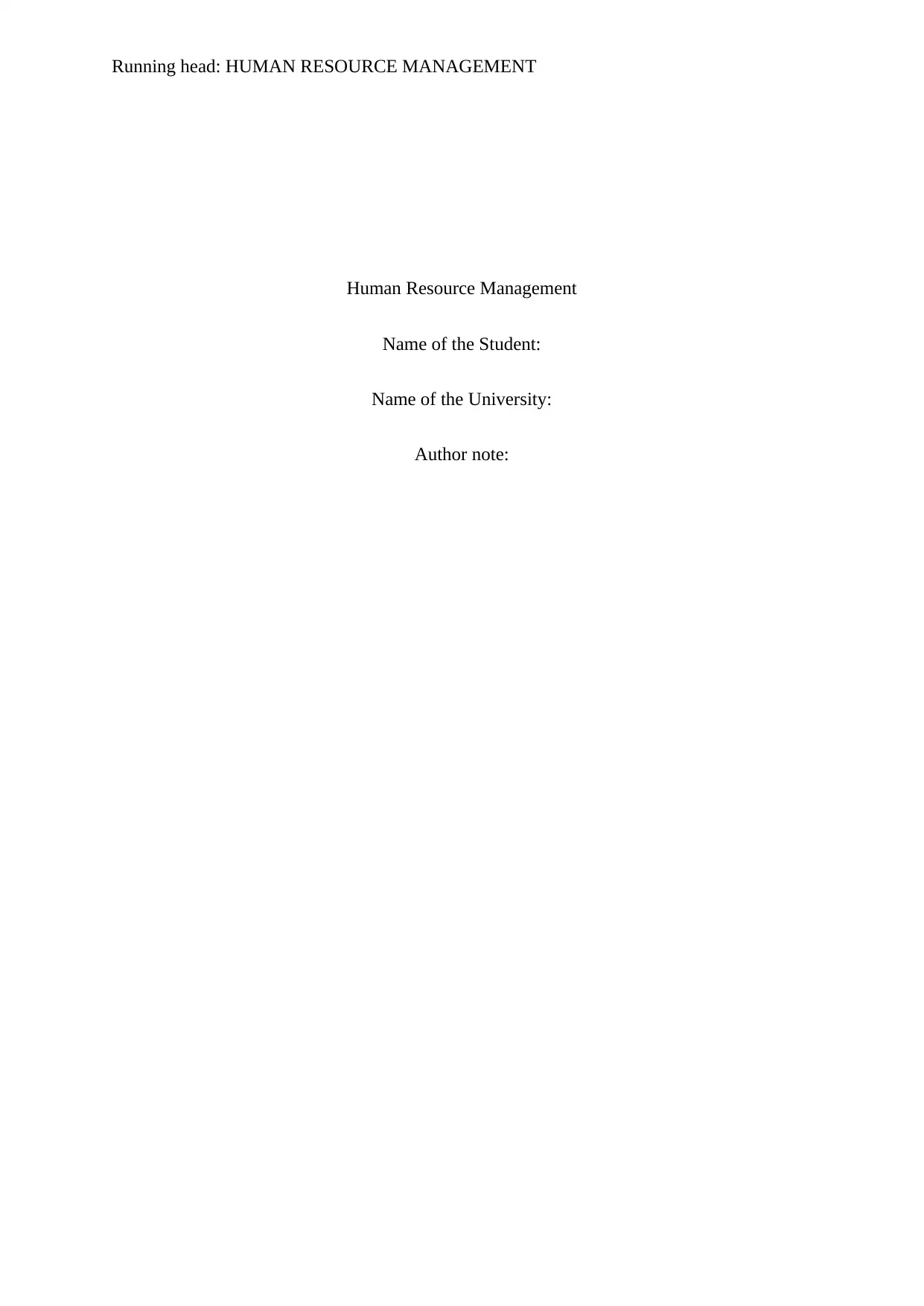
Running head: HUMAN RESOURCE MANAGEMENT
Human Resource Management
Name of the Student:
Name of the University:
Author note:
Human Resource Management
Name of the Student:
Name of the University:
Author note:
Paraphrase This Document
Need a fresh take? Get an instant paraphrase of this document with our AI Paraphraser
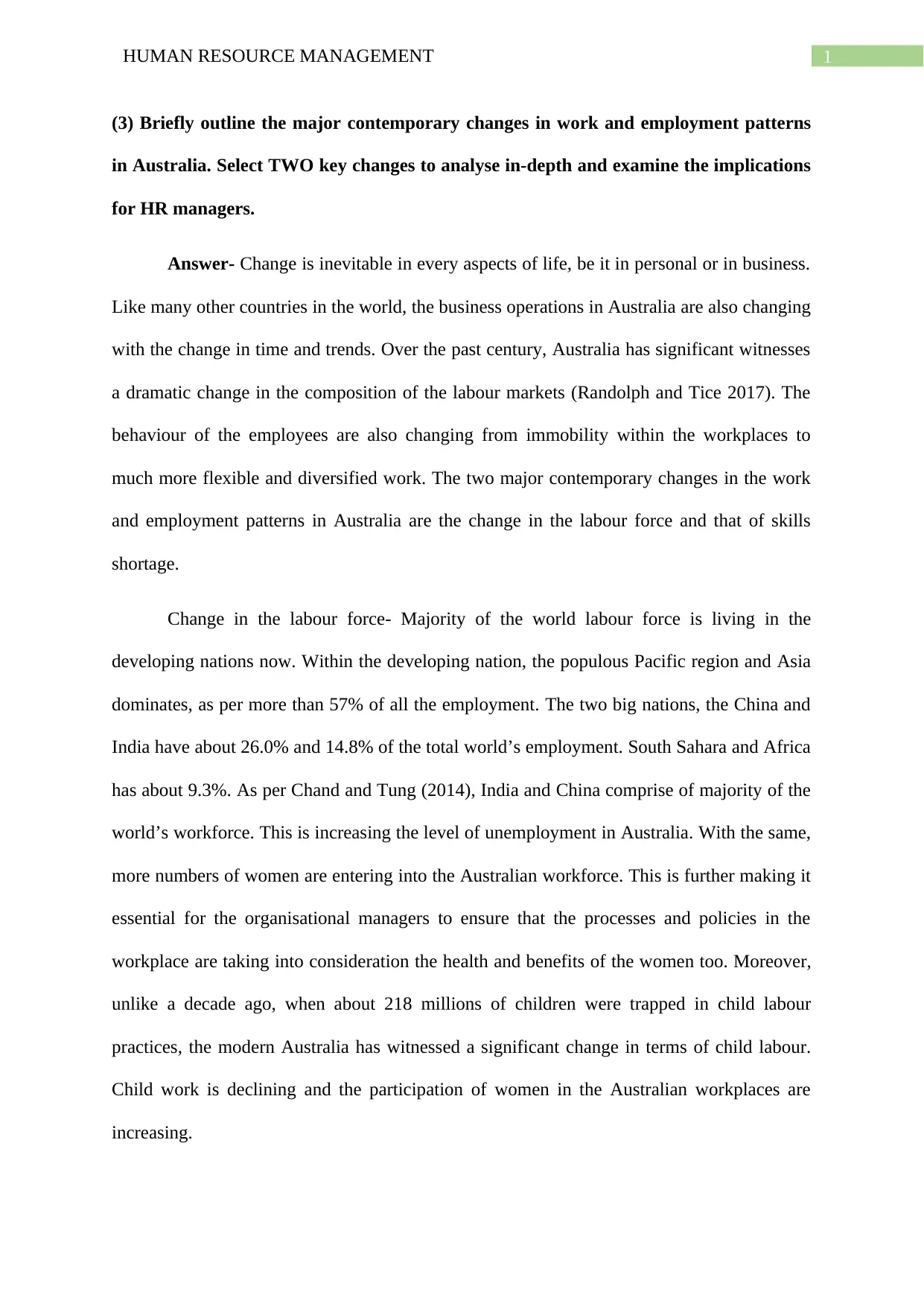
1HUMAN RESOURCE MANAGEMENT
(3) Briefly outline the major contemporary changes in work and employment patterns
in Australia. Select TWO key changes to analyse in-depth and examine the implications
for HR managers.
Answer- Change is inevitable in every aspects of life, be it in personal or in business.
Like many other countries in the world, the business operations in Australia are also changing
with the change in time and trends. Over the past century, Australia has significant witnesses
a dramatic change in the composition of the labour markets (Randolph and Tice 2017). The
behaviour of the employees are also changing from immobility within the workplaces to
much more flexible and diversified work. The two major contemporary changes in the work
and employment patterns in Australia are the change in the labour force and that of skills
shortage.
Change in the labour force- Majority of the world labour force is living in the
developing nations now. Within the developing nation, the populous Pacific region and Asia
dominates, as per more than 57% of all the employment. The two big nations, the China and
India have about 26.0% and 14.8% of the total world’s employment. South Sahara and Africa
has about 9.3%. As per Chand and Tung (2014), India and China comprise of majority of the
world’s workforce. This is increasing the level of unemployment in Australia. With the same,
more numbers of women are entering into the Australian workforce. This is further making it
essential for the organisational managers to ensure that the processes and policies in the
workplace are taking into consideration the health and benefits of the women too. Moreover,
unlike a decade ago, when about 218 millions of children were trapped in child labour
practices, the modern Australia has witnessed a significant change in terms of child labour.
Child work is declining and the participation of women in the Australian workplaces are
increasing.
(3) Briefly outline the major contemporary changes in work and employment patterns
in Australia. Select TWO key changes to analyse in-depth and examine the implications
for HR managers.
Answer- Change is inevitable in every aspects of life, be it in personal or in business.
Like many other countries in the world, the business operations in Australia are also changing
with the change in time and trends. Over the past century, Australia has significant witnesses
a dramatic change in the composition of the labour markets (Randolph and Tice 2017). The
behaviour of the employees are also changing from immobility within the workplaces to
much more flexible and diversified work. The two major contemporary changes in the work
and employment patterns in Australia are the change in the labour force and that of skills
shortage.
Change in the labour force- Majority of the world labour force is living in the
developing nations now. Within the developing nation, the populous Pacific region and Asia
dominates, as per more than 57% of all the employment. The two big nations, the China and
India have about 26.0% and 14.8% of the total world’s employment. South Sahara and Africa
has about 9.3%. As per Chand and Tung (2014), India and China comprise of majority of the
world’s workforce. This is increasing the level of unemployment in Australia. With the same,
more numbers of women are entering into the Australian workforce. This is further making it
essential for the organisational managers to ensure that the processes and policies in the
workplace are taking into consideration the health and benefits of the women too. Moreover,
unlike a decade ago, when about 218 millions of children were trapped in child labour
practices, the modern Australia has witnessed a significant change in terms of child labour.
Child work is declining and the participation of women in the Australian workplaces are
increasing.
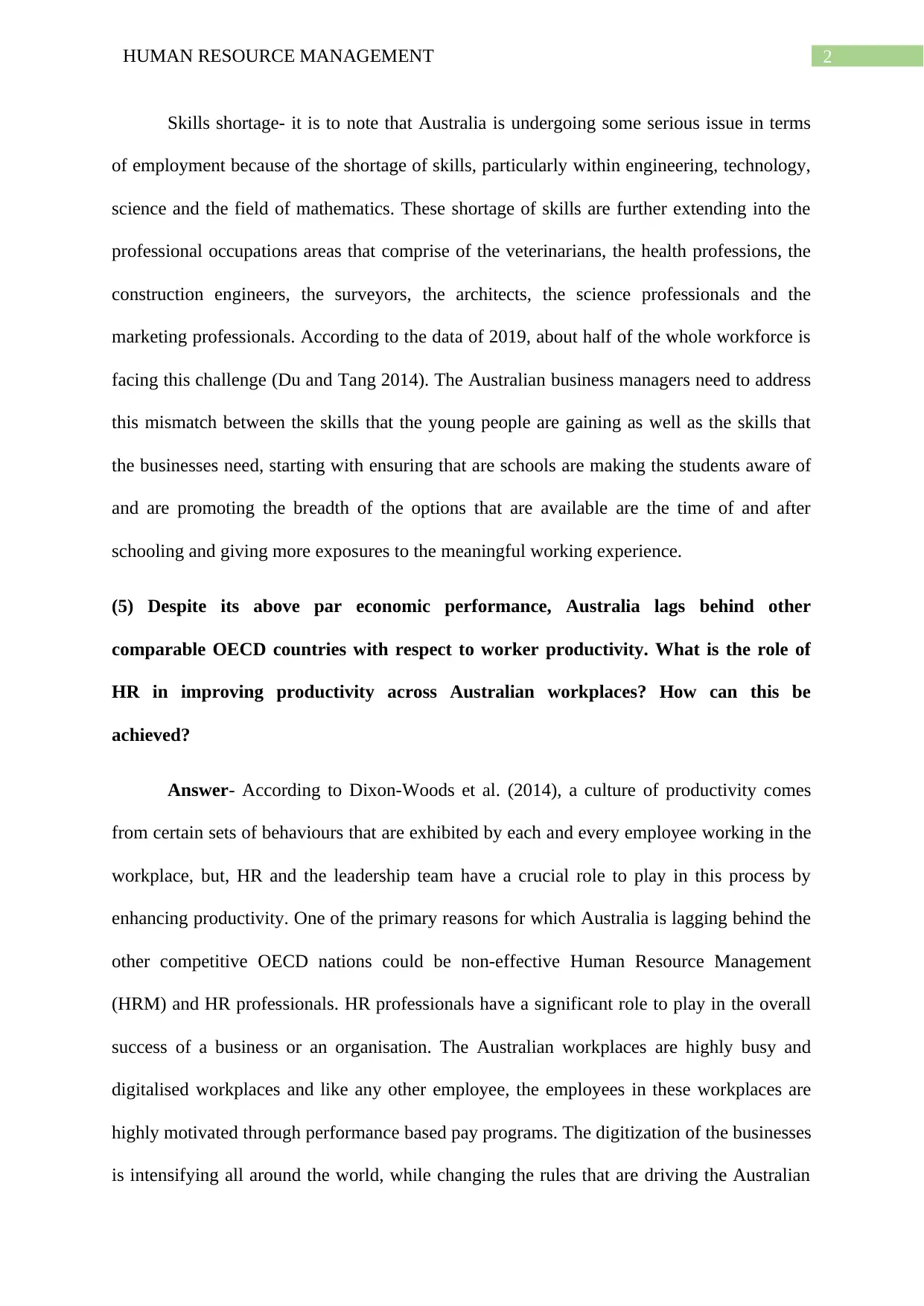
2HUMAN RESOURCE MANAGEMENT
Skills shortage- it is to note that Australia is undergoing some serious issue in terms
of employment because of the shortage of skills, particularly within engineering, technology,
science and the field of mathematics. These shortage of skills are further extending into the
professional occupations areas that comprise of the veterinarians, the health professions, the
construction engineers, the surveyors, the architects, the science professionals and the
marketing professionals. According to the data of 2019, about half of the whole workforce is
facing this challenge (Du and Tang 2014). The Australian business managers need to address
this mismatch between the skills that the young people are gaining as well as the skills that
the businesses need, starting with ensuring that are schools are making the students aware of
and are promoting the breadth of the options that are available are the time of and after
schooling and giving more exposures to the meaningful working experience.
(5) Despite its above par economic performance, Australia lags behind other
comparable OECD countries with respect to worker productivity. What is the role of
HR in improving productivity across Australian workplaces? How can this be
achieved?
Answer- According to Dixon-Woods et al. (2014), a culture of productivity comes
from certain sets of behaviours that are exhibited by each and every employee working in the
workplace, but, HR and the leadership team have a crucial role to play in this process by
enhancing productivity. One of the primary reasons for which Australia is lagging behind the
other competitive OECD nations could be non-effective Human Resource Management
(HRM) and HR professionals. HR professionals have a significant role to play in the overall
success of a business or an organisation. The Australian workplaces are highly busy and
digitalised workplaces and like any other employee, the employees in these workplaces are
highly motivated through performance based pay programs. The digitization of the businesses
is intensifying all around the world, while changing the rules that are driving the Australian
Skills shortage- it is to note that Australia is undergoing some serious issue in terms
of employment because of the shortage of skills, particularly within engineering, technology,
science and the field of mathematics. These shortage of skills are further extending into the
professional occupations areas that comprise of the veterinarians, the health professions, the
construction engineers, the surveyors, the architects, the science professionals and the
marketing professionals. According to the data of 2019, about half of the whole workforce is
facing this challenge (Du and Tang 2014). The Australian business managers need to address
this mismatch between the skills that the young people are gaining as well as the skills that
the businesses need, starting with ensuring that are schools are making the students aware of
and are promoting the breadth of the options that are available are the time of and after
schooling and giving more exposures to the meaningful working experience.
(5) Despite its above par economic performance, Australia lags behind other
comparable OECD countries with respect to worker productivity. What is the role of
HR in improving productivity across Australian workplaces? How can this be
achieved?
Answer- According to Dixon-Woods et al. (2014), a culture of productivity comes
from certain sets of behaviours that are exhibited by each and every employee working in the
workplace, but, HR and the leadership team have a crucial role to play in this process by
enhancing productivity. One of the primary reasons for which Australia is lagging behind the
other competitive OECD nations could be non-effective Human Resource Management
(HRM) and HR professionals. HR professionals have a significant role to play in the overall
success of a business or an organisation. The Australian workplaces are highly busy and
digitalised workplaces and like any other employee, the employees in these workplaces are
highly motivated through performance based pay programs. The digitization of the businesses
is intensifying all around the world, while changing the rules that are driving the Australian
⊘ This is a preview!⊘
Do you want full access?
Subscribe today to unlock all pages.

Trusted by 1+ million students worldwide
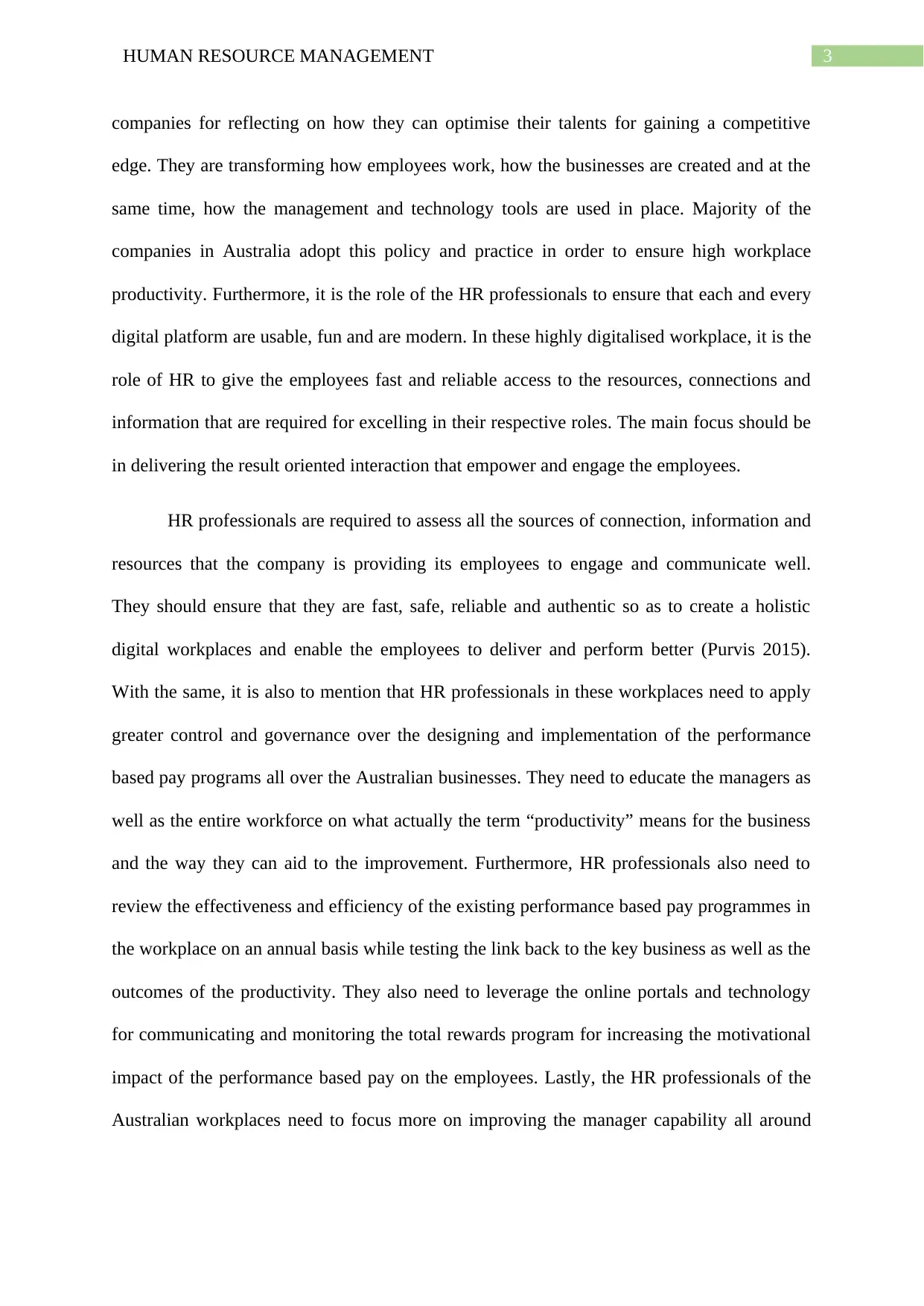
3HUMAN RESOURCE MANAGEMENT
companies for reflecting on how they can optimise their talents for gaining a competitive
edge. They are transforming how employees work, how the businesses are created and at the
same time, how the management and technology tools are used in place. Majority of the
companies in Australia adopt this policy and practice in order to ensure high workplace
productivity. Furthermore, it is the role of the HR professionals to ensure that each and every
digital platform are usable, fun and are modern. In these highly digitalised workplace, it is the
role of HR to give the employees fast and reliable access to the resources, connections and
information that are required for excelling in their respective roles. The main focus should be
in delivering the result oriented interaction that empower and engage the employees.
HR professionals are required to assess all the sources of connection, information and
resources that the company is providing its employees to engage and communicate well.
They should ensure that they are fast, safe, reliable and authentic so as to create a holistic
digital workplaces and enable the employees to deliver and perform better (Purvis 2015).
With the same, it is also to mention that HR professionals in these workplaces need to apply
greater control and governance over the designing and implementation of the performance
based pay programs all over the Australian businesses. They need to educate the managers as
well as the entire workforce on what actually the term “productivity” means for the business
and the way they can aid to the improvement. Furthermore, HR professionals also need to
review the effectiveness and efficiency of the existing performance based pay programmes in
the workplace on an annual basis while testing the link back to the key business as well as the
outcomes of the productivity. They also need to leverage the online portals and technology
for communicating and monitoring the total rewards program for increasing the motivational
impact of the performance based pay on the employees. Lastly, the HR professionals of the
Australian workplaces need to focus more on improving the manager capability all around
companies for reflecting on how they can optimise their talents for gaining a competitive
edge. They are transforming how employees work, how the businesses are created and at the
same time, how the management and technology tools are used in place. Majority of the
companies in Australia adopt this policy and practice in order to ensure high workplace
productivity. Furthermore, it is the role of the HR professionals to ensure that each and every
digital platform are usable, fun and are modern. In these highly digitalised workplace, it is the
role of HR to give the employees fast and reliable access to the resources, connections and
information that are required for excelling in their respective roles. The main focus should be
in delivering the result oriented interaction that empower and engage the employees.
HR professionals are required to assess all the sources of connection, information and
resources that the company is providing its employees to engage and communicate well.
They should ensure that they are fast, safe, reliable and authentic so as to create a holistic
digital workplaces and enable the employees to deliver and perform better (Purvis 2015).
With the same, it is also to mention that HR professionals in these workplaces need to apply
greater control and governance over the designing and implementation of the performance
based pay programs all over the Australian businesses. They need to educate the managers as
well as the entire workforce on what actually the term “productivity” means for the business
and the way they can aid to the improvement. Furthermore, HR professionals also need to
review the effectiveness and efficiency of the existing performance based pay programmes in
the workplace on an annual basis while testing the link back to the key business as well as the
outcomes of the productivity. They also need to leverage the online portals and technology
for communicating and monitoring the total rewards program for increasing the motivational
impact of the performance based pay on the employees. Lastly, the HR professionals of the
Australian workplaces need to focus more on improving the manager capability all around
Paraphrase This Document
Need a fresh take? Get an instant paraphrase of this document with our AI Paraphraser
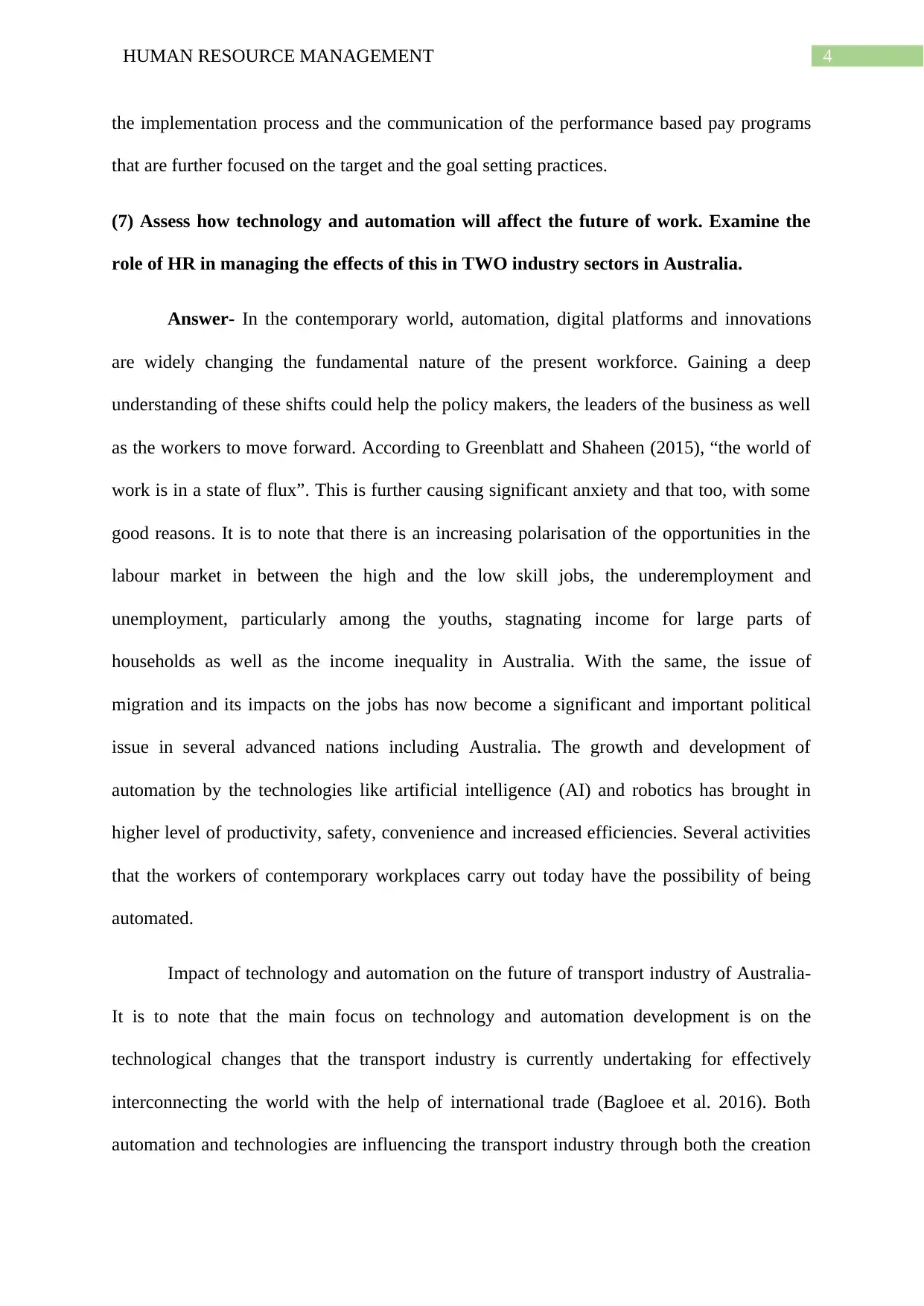
4HUMAN RESOURCE MANAGEMENT
the implementation process and the communication of the performance based pay programs
that are further focused on the target and the goal setting practices.
(7) Assess how technology and automation will affect the future of work. Examine the
role of HR in managing the effects of this in TWO industry sectors in Australia.
Answer- In the contemporary world, automation, digital platforms and innovations
are widely changing the fundamental nature of the present workforce. Gaining a deep
understanding of these shifts could help the policy makers, the leaders of the business as well
as the workers to move forward. According to Greenblatt and Shaheen (2015), “the world of
work is in a state of flux”. This is further causing significant anxiety and that too, with some
good reasons. It is to note that there is an increasing polarisation of the opportunities in the
labour market in between the high and the low skill jobs, the underemployment and
unemployment, particularly among the youths, stagnating income for large parts of
households as well as the income inequality in Australia. With the same, the issue of
migration and its impacts on the jobs has now become a significant and important political
issue in several advanced nations including Australia. The growth and development of
automation by the technologies like artificial intelligence (AI) and robotics has brought in
higher level of productivity, safety, convenience and increased efficiencies. Several activities
that the workers of contemporary workplaces carry out today have the possibility of being
automated.
Impact of technology and automation on the future of transport industry of Australia-
It is to note that the main focus on technology and automation development is on the
technological changes that the transport industry is currently undertaking for effectively
interconnecting the world with the help of international trade (Bagloee et al. 2016). Both
automation and technologies are influencing the transport industry through both the creation
the implementation process and the communication of the performance based pay programs
that are further focused on the target and the goal setting practices.
(7) Assess how technology and automation will affect the future of work. Examine the
role of HR in managing the effects of this in TWO industry sectors in Australia.
Answer- In the contemporary world, automation, digital platforms and innovations
are widely changing the fundamental nature of the present workforce. Gaining a deep
understanding of these shifts could help the policy makers, the leaders of the business as well
as the workers to move forward. According to Greenblatt and Shaheen (2015), “the world of
work is in a state of flux”. This is further causing significant anxiety and that too, with some
good reasons. It is to note that there is an increasing polarisation of the opportunities in the
labour market in between the high and the low skill jobs, the underemployment and
unemployment, particularly among the youths, stagnating income for large parts of
households as well as the income inequality in Australia. With the same, the issue of
migration and its impacts on the jobs has now become a significant and important political
issue in several advanced nations including Australia. The growth and development of
automation by the technologies like artificial intelligence (AI) and robotics has brought in
higher level of productivity, safety, convenience and increased efficiencies. Several activities
that the workers of contemporary workplaces carry out today have the possibility of being
automated.
Impact of technology and automation on the future of transport industry of Australia-
It is to note that the main focus on technology and automation development is on the
technological changes that the transport industry is currently undertaking for effectively
interconnecting the world with the help of international trade (Bagloee et al. 2016). Both
automation and technologies are influencing the transport industry through both the creation
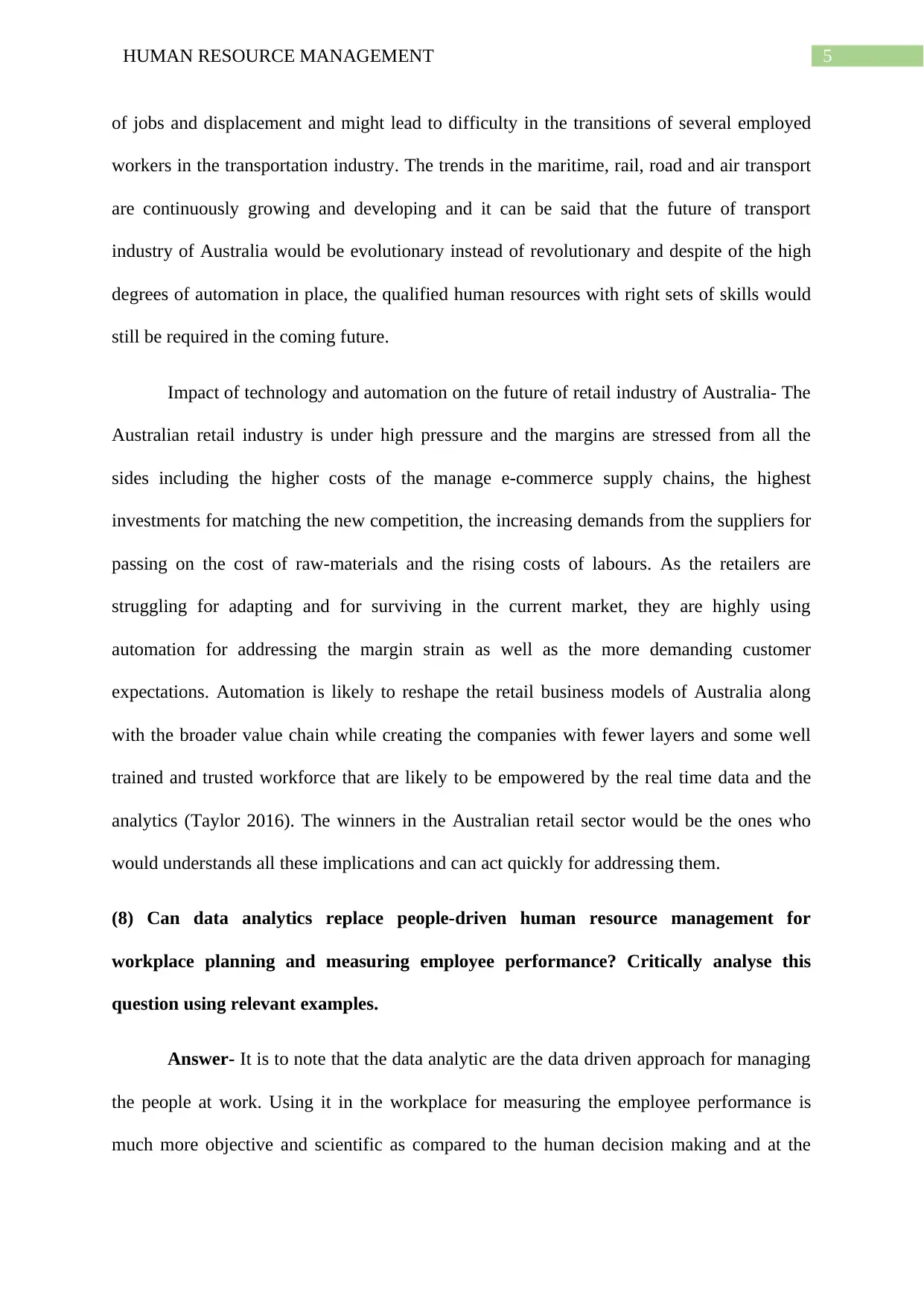
5HUMAN RESOURCE MANAGEMENT
of jobs and displacement and might lead to difficulty in the transitions of several employed
workers in the transportation industry. The trends in the maritime, rail, road and air transport
are continuously growing and developing and it can be said that the future of transport
industry of Australia would be evolutionary instead of revolutionary and despite of the high
degrees of automation in place, the qualified human resources with right sets of skills would
still be required in the coming future.
Impact of technology and automation on the future of retail industry of Australia- The
Australian retail industry is under high pressure and the margins are stressed from all the
sides including the higher costs of the manage e-commerce supply chains, the highest
investments for matching the new competition, the increasing demands from the suppliers for
passing on the cost of raw-materials and the rising costs of labours. As the retailers are
struggling for adapting and for surviving in the current market, they are highly using
automation for addressing the margin strain as well as the more demanding customer
expectations. Automation is likely to reshape the retail business models of Australia along
with the broader value chain while creating the companies with fewer layers and some well
trained and trusted workforce that are likely to be empowered by the real time data and the
analytics (Taylor 2016). The winners in the Australian retail sector would be the ones who
would understands all these implications and can act quickly for addressing them.
(8) Can data analytics replace people-driven human resource management for
workplace planning and measuring employee performance? Critically analyse this
question using relevant examples.
Answer- It is to note that the data analytic are the data driven approach for managing
the people at work. Using it in the workplace for measuring the employee performance is
much more objective and scientific as compared to the human decision making and at the
of jobs and displacement and might lead to difficulty in the transitions of several employed
workers in the transportation industry. The trends in the maritime, rail, road and air transport
are continuously growing and developing and it can be said that the future of transport
industry of Australia would be evolutionary instead of revolutionary and despite of the high
degrees of automation in place, the qualified human resources with right sets of skills would
still be required in the coming future.
Impact of technology and automation on the future of retail industry of Australia- The
Australian retail industry is under high pressure and the margins are stressed from all the
sides including the higher costs of the manage e-commerce supply chains, the highest
investments for matching the new competition, the increasing demands from the suppliers for
passing on the cost of raw-materials and the rising costs of labours. As the retailers are
struggling for adapting and for surviving in the current market, they are highly using
automation for addressing the margin strain as well as the more demanding customer
expectations. Automation is likely to reshape the retail business models of Australia along
with the broader value chain while creating the companies with fewer layers and some well
trained and trusted workforce that are likely to be empowered by the real time data and the
analytics (Taylor 2016). The winners in the Australian retail sector would be the ones who
would understands all these implications and can act quickly for addressing them.
(8) Can data analytics replace people-driven human resource management for
workplace planning and measuring employee performance? Critically analyse this
question using relevant examples.
Answer- It is to note that the data analytic are the data driven approach for managing
the people at work. Using it in the workplace for measuring the employee performance is
much more objective and scientific as compared to the human decision making and at the
⊘ This is a preview!⊘
Do you want full access?
Subscribe today to unlock all pages.

Trusted by 1+ million students worldwide
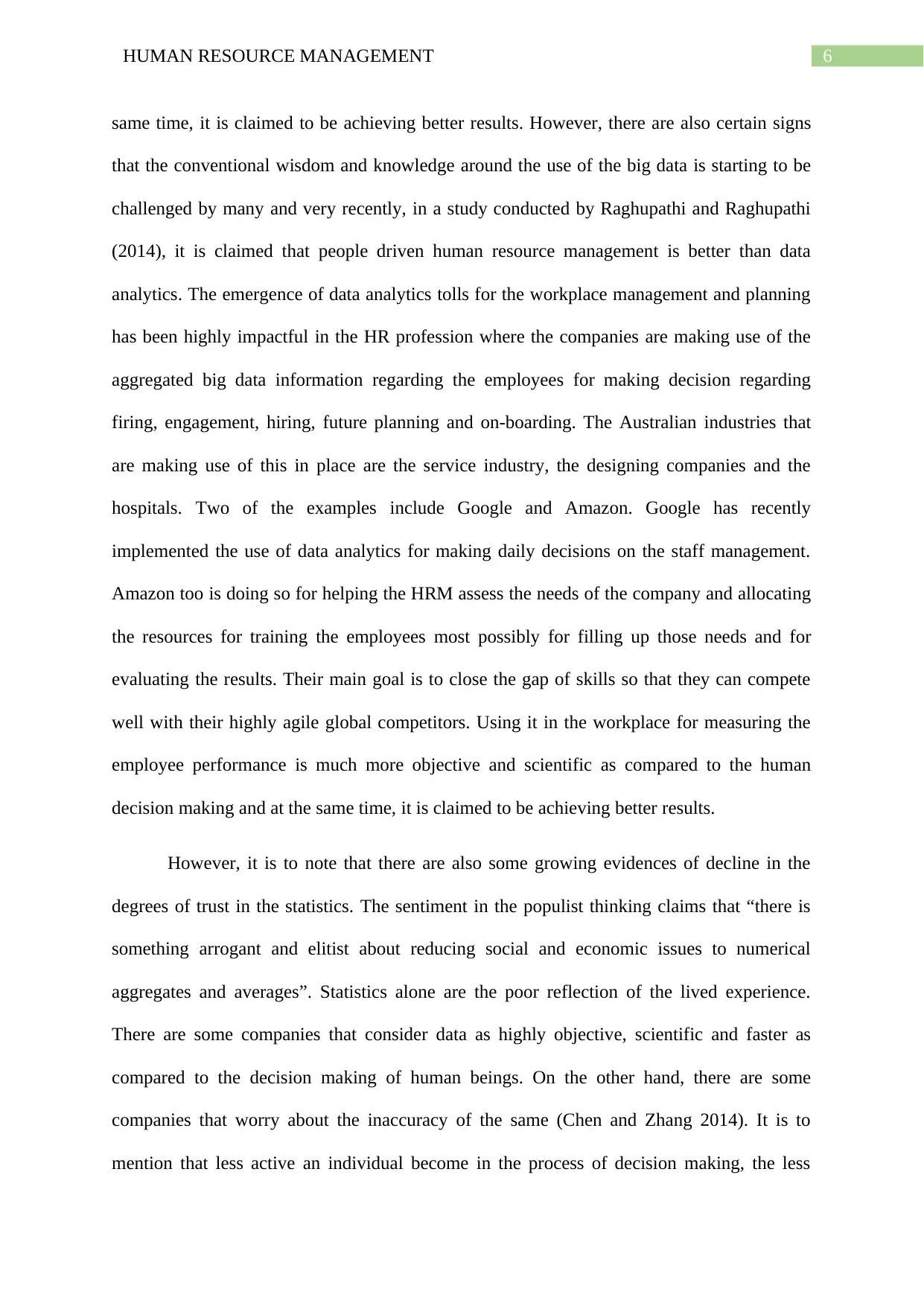
6HUMAN RESOURCE MANAGEMENT
same time, it is claimed to be achieving better results. However, there are also certain signs
that the conventional wisdom and knowledge around the use of the big data is starting to be
challenged by many and very recently, in a study conducted by Raghupathi and Raghupathi
(2014), it is claimed that people driven human resource management is better than data
analytics. The emergence of data analytics tolls for the workplace management and planning
has been highly impactful in the HR profession where the companies are making use of the
aggregated big data information regarding the employees for making decision regarding
firing, engagement, hiring, future planning and on-boarding. The Australian industries that
are making use of this in place are the service industry, the designing companies and the
hospitals. Two of the examples include Google and Amazon. Google has recently
implemented the use of data analytics for making daily decisions on the staff management.
Amazon too is doing so for helping the HRM assess the needs of the company and allocating
the resources for training the employees most possibly for filling up those needs and for
evaluating the results. Their main goal is to close the gap of skills so that they can compete
well with their highly agile global competitors. Using it in the workplace for measuring the
employee performance is much more objective and scientific as compared to the human
decision making and at the same time, it is claimed to be achieving better results.
However, it is to note that there are also some growing evidences of decline in the
degrees of trust in the statistics. The sentiment in the populist thinking claims that “there is
something arrogant and elitist about reducing social and economic issues to numerical
aggregates and averages”. Statistics alone are the poor reflection of the lived experience.
There are some companies that consider data as highly objective, scientific and faster as
compared to the decision making of human beings. On the other hand, there are some
companies that worry about the inaccuracy of the same (Chen and Zhang 2014). It is to
mention that less active an individual become in the process of decision making, the less
same time, it is claimed to be achieving better results. However, there are also certain signs
that the conventional wisdom and knowledge around the use of the big data is starting to be
challenged by many and very recently, in a study conducted by Raghupathi and Raghupathi
(2014), it is claimed that people driven human resource management is better than data
analytics. The emergence of data analytics tolls for the workplace management and planning
has been highly impactful in the HR profession where the companies are making use of the
aggregated big data information regarding the employees for making decision regarding
firing, engagement, hiring, future planning and on-boarding. The Australian industries that
are making use of this in place are the service industry, the designing companies and the
hospitals. Two of the examples include Google and Amazon. Google has recently
implemented the use of data analytics for making daily decisions on the staff management.
Amazon too is doing so for helping the HRM assess the needs of the company and allocating
the resources for training the employees most possibly for filling up those needs and for
evaluating the results. Their main goal is to close the gap of skills so that they can compete
well with their highly agile global competitors. Using it in the workplace for measuring the
employee performance is much more objective and scientific as compared to the human
decision making and at the same time, it is claimed to be achieving better results.
However, it is to note that there are also some growing evidences of decline in the
degrees of trust in the statistics. The sentiment in the populist thinking claims that “there is
something arrogant and elitist about reducing social and economic issues to numerical
aggregates and averages”. Statistics alone are the poor reflection of the lived experience.
There are some companies that consider data as highly objective, scientific and faster as
compared to the decision making of human beings. On the other hand, there are some
companies that worry about the inaccuracy of the same (Chen and Zhang 2014). It is to
mention that less active an individual become in the process of decision making, the less
Paraphrase This Document
Need a fresh take? Get an instant paraphrase of this document with our AI Paraphraser
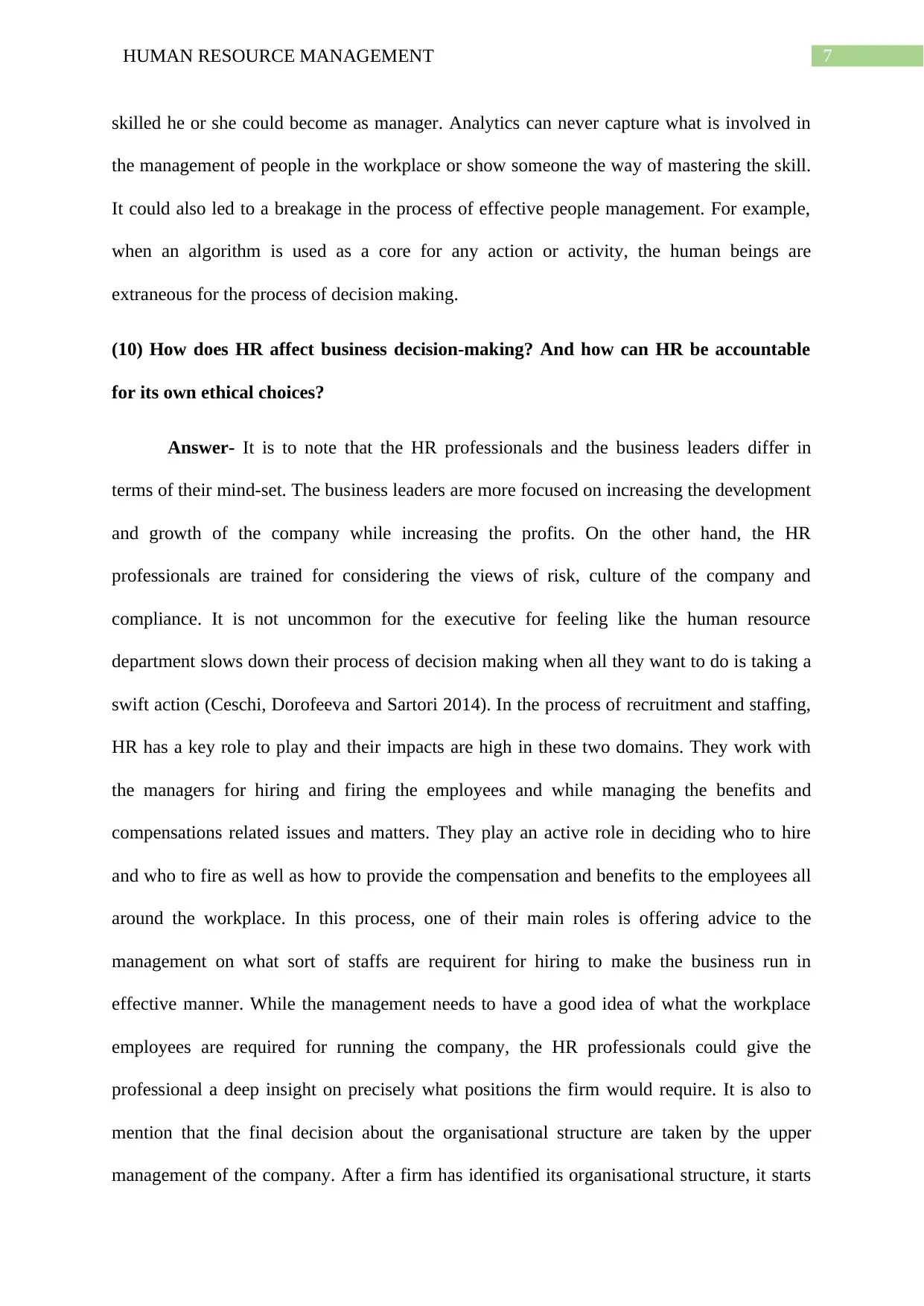
7HUMAN RESOURCE MANAGEMENT
skilled he or she could become as manager. Analytics can never capture what is involved in
the management of people in the workplace or show someone the way of mastering the skill.
It could also led to a breakage in the process of effective people management. For example,
when an algorithm is used as a core for any action or activity, the human beings are
extraneous for the process of decision making.
(10) How does HR affect business decision-making? And how can HR be accountable
for its own ethical choices?
Answer- It is to note that the HR professionals and the business leaders differ in
terms of their mind-set. The business leaders are more focused on increasing the development
and growth of the company while increasing the profits. On the other hand, the HR
professionals are trained for considering the views of risk, culture of the company and
compliance. It is not uncommon for the executive for feeling like the human resource
department slows down their process of decision making when all they want to do is taking a
swift action (Ceschi, Dorofeeva and Sartori 2014). In the process of recruitment and staffing,
HR has a key role to play and their impacts are high in these two domains. They work with
the managers for hiring and firing the employees and while managing the benefits and
compensations related issues and matters. They play an active role in deciding who to hire
and who to fire as well as how to provide the compensation and benefits to the employees all
around the workplace. In this process, one of their main roles is offering advice to the
management on what sort of staffs are requirent for hiring to make the business run in
effective manner. While the management needs to have a good idea of what the workplace
employees are required for running the company, the HR professionals could give the
professional a deep insight on precisely what positions the firm would require. It is also to
mention that the final decision about the organisational structure are taken by the upper
management of the company. After a firm has identified its organisational structure, it starts
skilled he or she could become as manager. Analytics can never capture what is involved in
the management of people in the workplace or show someone the way of mastering the skill.
It could also led to a breakage in the process of effective people management. For example,
when an algorithm is used as a core for any action or activity, the human beings are
extraneous for the process of decision making.
(10) How does HR affect business decision-making? And how can HR be accountable
for its own ethical choices?
Answer- It is to note that the HR professionals and the business leaders differ in
terms of their mind-set. The business leaders are more focused on increasing the development
and growth of the company while increasing the profits. On the other hand, the HR
professionals are trained for considering the views of risk, culture of the company and
compliance. It is not uncommon for the executive for feeling like the human resource
department slows down their process of decision making when all they want to do is taking a
swift action (Ceschi, Dorofeeva and Sartori 2014). In the process of recruitment and staffing,
HR has a key role to play and their impacts are high in these two domains. They work with
the managers for hiring and firing the employees and while managing the benefits and
compensations related issues and matters. They play an active role in deciding who to hire
and who to fire as well as how to provide the compensation and benefits to the employees all
around the workplace. In this process, one of their main roles is offering advice to the
management on what sort of staffs are requirent for hiring to make the business run in
effective manner. While the management needs to have a good idea of what the workplace
employees are required for running the company, the HR professionals could give the
professional a deep insight on precisely what positions the firm would require. It is also to
mention that the final decision about the organisational structure are taken by the upper
management of the company. After a firm has identified its organisational structure, it starts
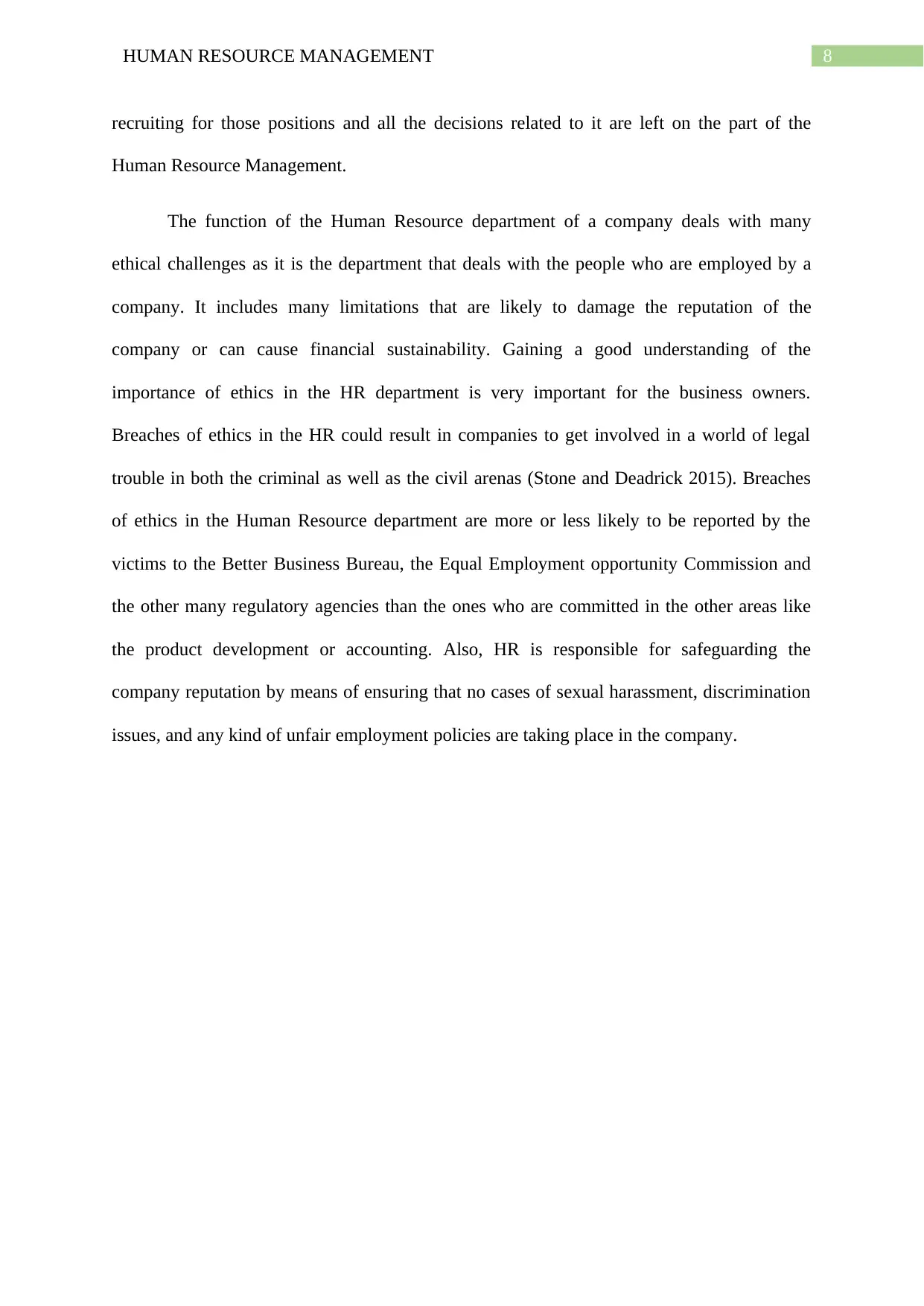
8HUMAN RESOURCE MANAGEMENT
recruiting for those positions and all the decisions related to it are left on the part of the
Human Resource Management.
The function of the Human Resource department of a company deals with many
ethical challenges as it is the department that deals with the people who are employed by a
company. It includes many limitations that are likely to damage the reputation of the
company or can cause financial sustainability. Gaining a good understanding of the
importance of ethics in the HR department is very important for the business owners.
Breaches of ethics in the HR could result in companies to get involved in a world of legal
trouble in both the criminal as well as the civil arenas (Stone and Deadrick 2015). Breaches
of ethics in the Human Resource department are more or less likely to be reported by the
victims to the Better Business Bureau, the Equal Employment opportunity Commission and
the other many regulatory agencies than the ones who are committed in the other areas like
the product development or accounting. Also, HR is responsible for safeguarding the
company reputation by means of ensuring that no cases of sexual harassment, discrimination
issues, and any kind of unfair employment policies are taking place in the company.
recruiting for those positions and all the decisions related to it are left on the part of the
Human Resource Management.
The function of the Human Resource department of a company deals with many
ethical challenges as it is the department that deals with the people who are employed by a
company. It includes many limitations that are likely to damage the reputation of the
company or can cause financial sustainability. Gaining a good understanding of the
importance of ethics in the HR department is very important for the business owners.
Breaches of ethics in the HR could result in companies to get involved in a world of legal
trouble in both the criminal as well as the civil arenas (Stone and Deadrick 2015). Breaches
of ethics in the Human Resource department are more or less likely to be reported by the
victims to the Better Business Bureau, the Equal Employment opportunity Commission and
the other many regulatory agencies than the ones who are committed in the other areas like
the product development or accounting. Also, HR is responsible for safeguarding the
company reputation by means of ensuring that no cases of sexual harassment, discrimination
issues, and any kind of unfair employment policies are taking place in the company.
⊘ This is a preview!⊘
Do you want full access?
Subscribe today to unlock all pages.

Trusted by 1+ million students worldwide
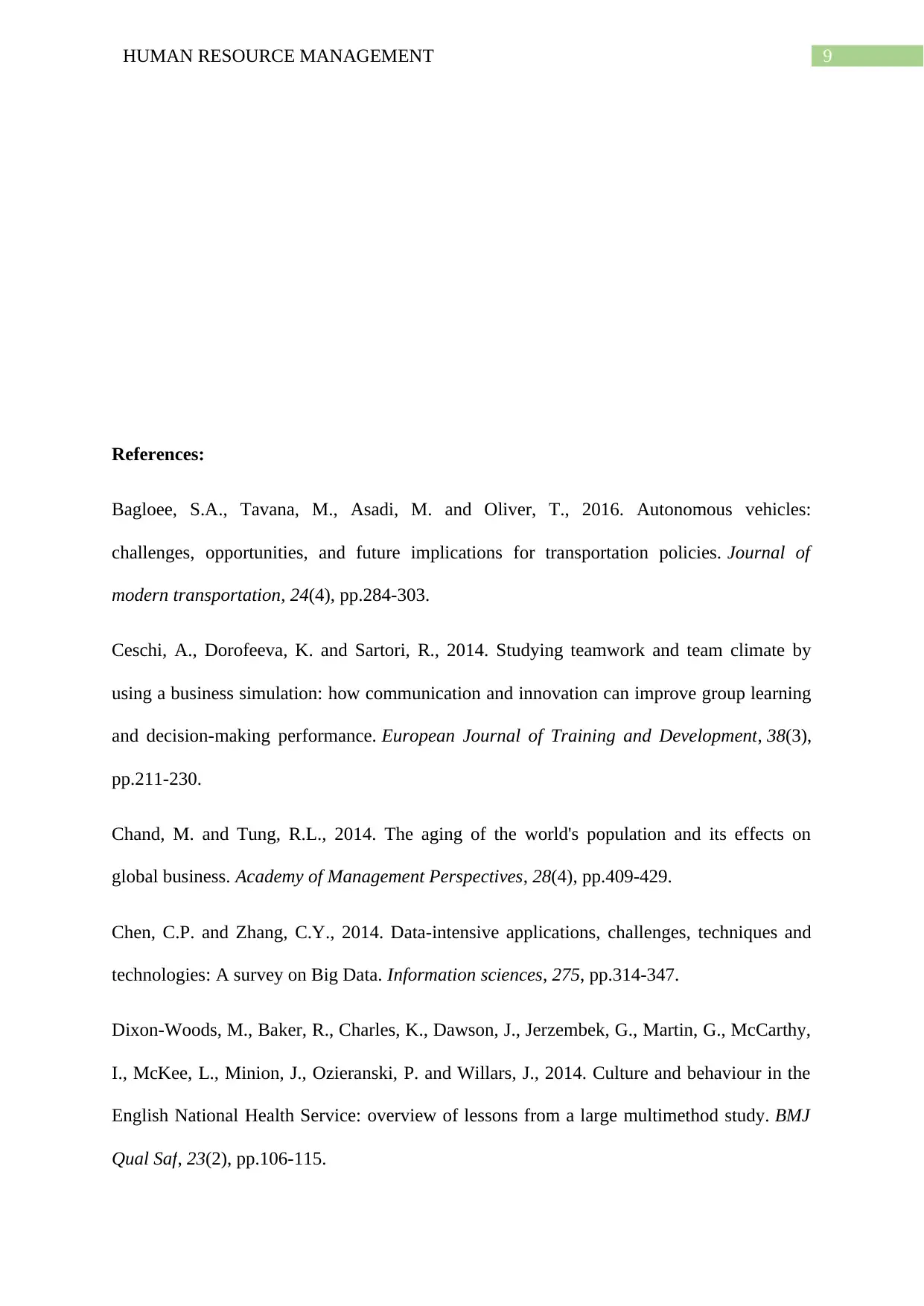
9HUMAN RESOURCE MANAGEMENT
References:
Bagloee, S.A., Tavana, M., Asadi, M. and Oliver, T., 2016. Autonomous vehicles:
challenges, opportunities, and future implications for transportation policies. Journal of
modern transportation, 24(4), pp.284-303.
Ceschi, A., Dorofeeva, K. and Sartori, R., 2014. Studying teamwork and team climate by
using a business simulation: how communication and innovation can improve group learning
and decision-making performance. European Journal of Training and Development, 38(3),
pp.211-230.
Chand, M. and Tung, R.L., 2014. The aging of the world's population and its effects on
global business. Academy of Management Perspectives, 28(4), pp.409-429.
Chen, C.P. and Zhang, C.Y., 2014. Data-intensive applications, challenges, techniques and
technologies: A survey on Big Data. Information sciences, 275, pp.314-347.
Dixon-Woods, M., Baker, R., Charles, K., Dawson, J., Jerzembek, G., Martin, G., McCarthy,
I., McKee, L., Minion, J., Ozieranski, P. and Willars, J., 2014. Culture and behaviour in the
English National Health Service: overview of lessons from a large multimethod study. BMJ
Qual Saf, 23(2), pp.106-115.
References:
Bagloee, S.A., Tavana, M., Asadi, M. and Oliver, T., 2016. Autonomous vehicles:
challenges, opportunities, and future implications for transportation policies. Journal of
modern transportation, 24(4), pp.284-303.
Ceschi, A., Dorofeeva, K. and Sartori, R., 2014. Studying teamwork and team climate by
using a business simulation: how communication and innovation can improve group learning
and decision-making performance. European Journal of Training and Development, 38(3),
pp.211-230.
Chand, M. and Tung, R.L., 2014. The aging of the world's population and its effects on
global business. Academy of Management Perspectives, 28(4), pp.409-429.
Chen, C.P. and Zhang, C.Y., 2014. Data-intensive applications, challenges, techniques and
technologies: A survey on Big Data. Information sciences, 275, pp.314-347.
Dixon-Woods, M., Baker, R., Charles, K., Dawson, J., Jerzembek, G., Martin, G., McCarthy,
I., McKee, L., Minion, J., Ozieranski, P. and Willars, J., 2014. Culture and behaviour in the
English National Health Service: overview of lessons from a large multimethod study. BMJ
Qual Saf, 23(2), pp.106-115.
Paraphrase This Document
Need a fresh take? Get an instant paraphrase of this document with our AI Paraphraser
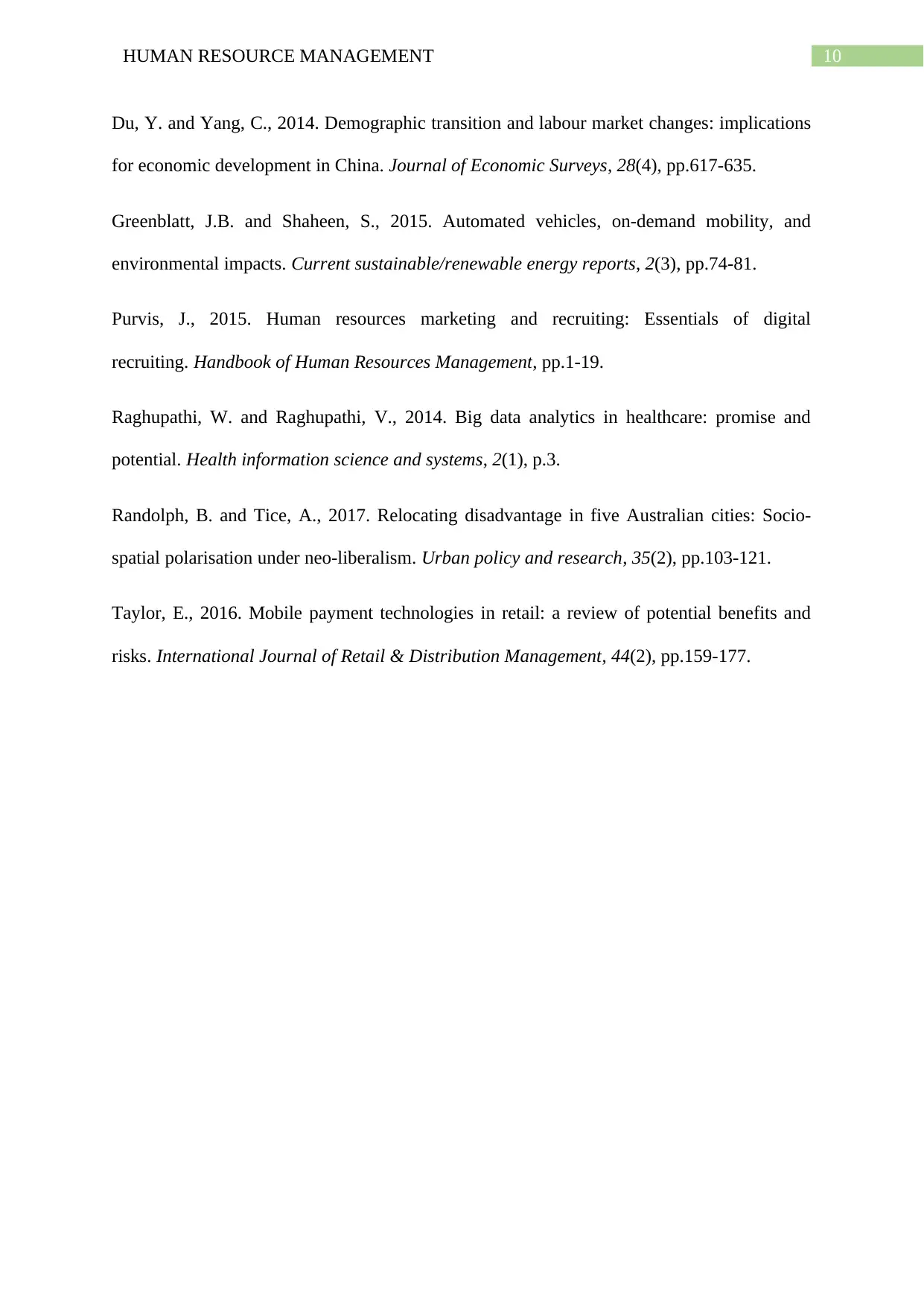
10HUMAN RESOURCE MANAGEMENT
Du, Y. and Yang, C., 2014. Demographic transition and labour market changes: implications
for economic development in China. Journal of Economic Surveys, 28(4), pp.617-635.
Greenblatt, J.B. and Shaheen, S., 2015. Automated vehicles, on-demand mobility, and
environmental impacts. Current sustainable/renewable energy reports, 2(3), pp.74-81.
Purvis, J., 2015. Human resources marketing and recruiting: Essentials of digital
recruiting. Handbook of Human Resources Management, pp.1-19.
Raghupathi, W. and Raghupathi, V., 2014. Big data analytics in healthcare: promise and
potential. Health information science and systems, 2(1), p.3.
Randolph, B. and Tice, A., 2017. Relocating disadvantage in five Australian cities: Socio-
spatial polarisation under neo-liberalism. Urban policy and research, 35(2), pp.103-121.
Taylor, E., 2016. Mobile payment technologies in retail: a review of potential benefits and
risks. International Journal of Retail & Distribution Management, 44(2), pp.159-177.
Du, Y. and Yang, C., 2014. Demographic transition and labour market changes: implications
for economic development in China. Journal of Economic Surveys, 28(4), pp.617-635.
Greenblatt, J.B. and Shaheen, S., 2015. Automated vehicles, on-demand mobility, and
environmental impacts. Current sustainable/renewable energy reports, 2(3), pp.74-81.
Purvis, J., 2015. Human resources marketing and recruiting: Essentials of digital
recruiting. Handbook of Human Resources Management, pp.1-19.
Raghupathi, W. and Raghupathi, V., 2014. Big data analytics in healthcare: promise and
potential. Health information science and systems, 2(1), p.3.
Randolph, B. and Tice, A., 2017. Relocating disadvantage in five Australian cities: Socio-
spatial polarisation under neo-liberalism. Urban policy and research, 35(2), pp.103-121.
Taylor, E., 2016. Mobile payment technologies in retail: a review of potential benefits and
risks. International Journal of Retail & Distribution Management, 44(2), pp.159-177.
1 out of 11
Related Documents
Your All-in-One AI-Powered Toolkit for Academic Success.
+13062052269
info@desklib.com
Available 24*7 on WhatsApp / Email
![[object Object]](/_next/static/media/star-bottom.7253800d.svg)
Unlock your academic potential
Copyright © 2020–2025 A2Z Services. All Rights Reserved. Developed and managed by ZUCOL.



